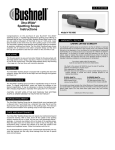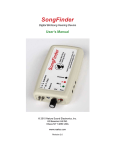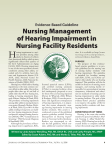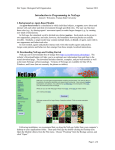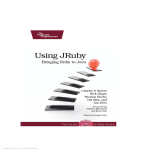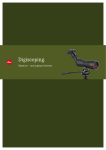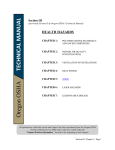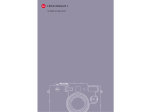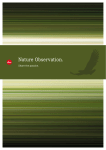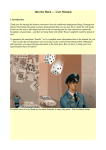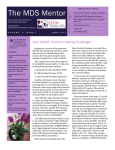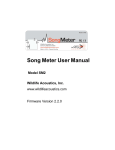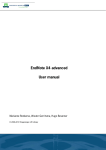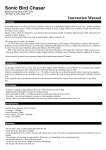Download The SongFinder
Transcript
SongFinder Digital Birdsong Hearing Device User’s Manual © 2005 Nature Sound Electronics, Inc. 63 Besemer Hill Rd. Ithaca NY 14850 USA www.nselec.com Revision 1.17 SongFinder Users Manual Overview: The SongFinder The SongFinder is an advanced digital device built for bird enthusiasts who suffer from high frequency hearing loss and who are unable to hear high-pitched bird songs in their natural surroundings. Unlike conventional amplifying-type hearing aids, the SongFinder works by lowering the frequency or pitch of bird songs into a range where the user has normal hearing. This method avoids the many pitfalls of extreme amplification. Furthermore, the SongFinder is a two-channel "binaural" device that allows the user to determine the directions and distances of singing birds. The SongFinder offers an elegant and tasteful solution for aging birders and other nature lovers who can no longer hear high singing birds. The Problem As we grow older, we experience diminished sensitivity to high frequency sounds. Youthful hearing extends as high as 20,000 Hz (Hz = cycles/second). However, the average person (especially among men) over fifty years of age has completely lost the very highest frequencies and often suffers moderate hearing loss in the range from 4,000 to 10,000 Hz. Moderate to severe hearing loss above 4,000-5,000 Hz becomes the norm for individuals living sixty and beyond. Loss of hearing with age, technically referred to as presbycusis, is a widespread phenomenon that seemingly cannot be avoided. To make matters worse, prolonged exposure to loud music and other loud background sounds also results in reduced sensitivity in the high range. This is NOT good news for aging birdwatchers! The average frequency of the songs of songbirds is about 4,000 Hz, approximately the same pitch as the highest note of a piano. Many warblers, sparrows, waxwings, kinglets, and a number of other birds produce sounds that reach 8,000 Hz and higher. Moderate to severe hearing loss in the 3,000-10,000 Hz range greatly reduces the ability of a birder to be aware of the presence of these high-pitched singers. The Traditional Solution: Amplification Aids The traditional approach to counteracting hearing loss has been to utilize amplifying hearing aids that raise the amplitude of incoming signals to levels where they can be heard. This approach works well in the realm of speech perception (mostly below 3000 Hz) but has limited application for birders and other nature lovers who are deaf to high-pitched bird songs but who have little trouble hearing speech. For aging birders, conventional amplifying-type hearing aids are usually a major disappointment. Some of the problems encountered with such devices are summarized as follows: 1) There is a limit to how much a hearing aid can amplify before feedback squeal occurs. If hearing loss is severe, maximum amplification will not be adequate to allow high bird songs to be heard at reasonable distances in typical outdoor situations. 2) Conventional aids generally do not produce good amplification above 5,000 Hz. Thus, most amplifying hearing aids offer little or no help with the highest singing birds. 3) Extraneous sounds such as wind noise or the sounds that accompany walking through leaves or stepping on twigs are also amplified and can be extremely annoying. Users often complain of "sensory overload" due to the continuous high-level amplification of such environmental sounds. 4) Even when users wear amplifying aids in both ears, the ability to determine distances and directions of incoming sounds is normally much reduced. The three dimensional or binaural © 2005 Nature Sound Electronics, Inc. Page 2 SongFinder Users Manual aspect of hearing is lost and it becomes difficult, if not impossible, to find birds, even when they are heard. The SongFinder: A Frequency Shifting Solution After 20 years of experimentation with a variety of devices, we have developed a digital instrument, the SongFinder, that is designed specifically for birders suffering from high frequency hearing loss, but who still have reasonably normal hearing in both ears up to around 2,000 Hz. As a reference point, if you have little trouble holding conversations with other people, then you probably have good hearing through 2,000 Hz.. The SongFinder works on a frequency dividing principle. Incoming sounds above 3,500 Hz are converted into digital signals that are acted upon by an internal digital signal processor (DSP) performing mathematical transformations that accomplish frequency division. As a result, high bird sounds are lowered into a frequency range where one has normal or near-normal hearing. The user chooses the degree of lowering, reducing the frequency of incoming high-pitched sounds to one-half, one-third, or one-quarter for the SongFinder. For example, a bird sound of 8,000 Hz will be perceived as 4,000 Hz when halved or 2,000 Hz when quartered. Using the SongFinder set to one-quarter, a person with severe high frequency hearing loss will often be able to hear ALL the highest singing birds! The SongFinder responds only to high frequency sounds above 3,500 Hz (optionally 4500 Hz). It is not based on an amplifying principle. Rather, the high-pitched sounds are lowered and then added, at normal amplitude or at slight to moderate amplification, to what one already hears. Since extreme amplification is never involved, extraneous sounds like the snapping of twigs do not become annoying. Sensory overload is completely avoided, feedback squeal does not occur, and the overall effect is gentle and natural. Furthermore, the unit is a two-channel "binaural" device that allows the user to determine the locaton of singing birds and insects. A small, loose-fitting binaural headset is worn which positions tiny microphones next to each ear. The two microphones pick up incoming high-pitched sounds and route them to the device that is stored in a shirt pocket or clipped on the belt. The two separate channels of high-pitched sounds are lowered and then fed back to each ear via miniature earphones that do not impair normal hearing. The result is a lifelike, three-dimensional binaural perception that allows the user to judge directions and distances of incoming sounds with amazing accuracy. Such pitch lowered nature sounds are perceived as natural and real, and the user is able to determine the whereabouts of the sound makers in the outdoor environment. Is The SongFinder Right For You? The SongFinder is designed for those suffering from moderate to severe high frequency hearing loss in the higher ranges, but who still have reasonably good hearing up to around 2,000 Hz in both ears. Such individuals are almost completely deaf to high-pitched bird songs but will be able to hear human speech and low singing birds such as whip-poor-wills, robins, and cardinals without the need for special hearing aid devices. While the SongFinder is primarily a pitch-lowering device, it also offers a reasonable degree of amplification of the lowered signals. Potential buyers might prefer to obtain an audiogram from an audiologist. Have the audiologist pay particular attention to high frequency response. Look for moderate to severe hearing loss above 4,000 Hz with normal or near-normal hearing up to around 2,000 Hz or beyond. If there is moderate loss at 2,000 Hz, the utility of the SongFinder will be somewhat reduced, although some people have used the SongFinder successfully in conjunction with amplification-type aids that provide the needed boost in the low range. © 2005 Nature Sound Electronics, Inc. Page 3 SongFinder Users Manual Operating the SongFinder The headset is worn on the head such that the loop extends behind the head as shown. The braided cable should be on the left. The processing unit is worn either on the belt with the belt clip provided or carried in a shirt or jacket pocket. The headset wires can be routed under clothing if desired to keep them from catching on branches or other obstacles. Set the volume control to the midway point and turn on the power (right switch). The red light should come on. The Mode switch selects between divide by 2, 3 or 4. You can test that the unit is operating by making a “psssssssst” noise or rattling a set of car keys while switching between the modes. You should hear the sound lowered in pitch by different amounts when you switch modes. © 2005 Nature Sound Electronics, Inc. Page 4 SongFinder Users Manual Batteries The SongFinder uses four AA sized 1.5 volt batteries. The battery compartment is on the top of the unit and the cover slides off towards the rear. Either standard alkaline AA cells or rechargeable AA cells may be used. When using rechargeable batteries, either the older Nickel-Cadmium (NiCd) or the newer Nickel-Metal-Hydride (NiMh) type may be used. The NiMh cells provide longer run time than NiCd cells. Note, do not use the old style carbon-zinc batteries as they are prone to leakage! These batteries are often labeled “Classic” or “General Purpose”. Also, do not use 3 volt lithium camera batteries even though they may be the same size as an AA battery. The SongFinder is designed for four 1.2 or 1.5 volt batteries only. Note that when the batteries start to go dead, the unit may work but will be very staticy. This is a sign that the batteries need replacing. Rechargeable Batteries When recharging NiCd or NiMh batteries be sure to use a charger designed for the type of battery being charged. NiCd and NiMh chargers are different and cannot be interchanged. Some newer chargers have a switch that selects between the two cell types and can be used with either. Also note that some chargers are designed for rapid charging (1-2 hours) and others for slow charging (12-16 hours). Be aware of this when purchasing a charger. When using a rapid charger make sure the cells you are charging are rated for rapid charging; some cells are not. Never attempt to recharge a non-rechargeable battery such as an alkaline cell. When using rechargeable batteries it is important to use four identical batteries as a set and keep that set together. Cells of different types or different manufacturers or of different charge states will have different energy capacities. Differences in energy capacity between cell types will result in one or more cells becoming discharged before the others. If one cell becomes totally discharged the SongFinder may actually continue running on three cells with the fourth being totally discharged. This discharged fourth cell may become damaged if left in this condition for an extended period of time. The rule of thumb is to keep sets of 4 batteries together from the day they are purchased. NiCd cells do not like to be partially discharged and recharged. They need to be fully discharged before recharging. If a NiCd cell is subjected to repeated shallow discharging/charging cycles it can develop a “memory” of this pattern and may be unable to be discharged beyond that point. NiMh cells do not exhibit © 2005 Nature Sound Electronics, Inc. Page 5 SongFinder Users Manual this effect and can be safely recharged at any time. The best advice for either type of cell, however, is to use them until they are fully discharged and then fully charge them. It’s best to avoid overcharging either type of battery. Take them out of the charger when they are fully charged. As a final note, it is best not to leave the SongFinder power switch on for extended periods of time after the batteries have become totally discharged. This may damage the batteries and shorten their life. In some cases NiCd cells have been known to leak under these conditions. Balance Adjustment The volume levels of each channel are approximately balanced in the manufacturing process. You may find that the balance needs slight adjustment for the particular user. If the sounds processed by the SongFinder consistently appear to be coming from an incorrect direction then the balance needs to be adjusted. If a different headset is ever used with your SongFinder then the balance may need to be readjusted. The balance control is located on the front panel of the unit. The balance is best adjusted in an open area so as to avoid sound reflected from nearby objects. A good way to adjust the balance is to play a bird sound identification compact disc using a small CD player placed about 20 feet away. An alternative sound source is to have a friend make squeaking sounds with an Audubon Bird Call at the same distance. You might want to play the warbler section of the CD as most warbler songs are high pitched. If you have a track repeat function, you should choose a particular track on the CD (a particular warbler) and set that track to keep repeating. Adjust the volume control of the SongFinder to 1/3 of full volume and put the unit in the divide by 2 mode. Close your eyes and spin around a few times so that you no longer know exactly where the sound source is. Listen to several songs and then point in the direction you think they are coming from. Then open your eyes and see if you're pointing at the source. Try this several times. If you find that you're consistently pointing to the right or left of the source, a balance adjustment should be performed. Turn the balance control to move the pitch-lowered sounds to one direction or the other. © 2005 Nature Sound Electronics, Inc. Page 6 SongFinder Users Manual Input Filters The SongFinder has internal filtering circuitry that rejects frequencies below the filter cutoff frequency. This prevents speech and other low frequency sounds from being lowered in pitch. The cutoff frequency has three settings controlled by the Filter switch on the front panel. The following table shows the filter cutoff frequencies for each setting. Switch Setting L M H Frequency 2.0 kHz 3.5 kHz 4.5 kHz For example, with the switch set to the “M” setting, input frequencies above 3.5 kHz are pitch divided and frequencies below 3.5 kHz are not processed. Users may wish to get an audiogram from an audiologist to determine where their hearing starts to fall off and choose the appropriate filter setting and leave it set to that setting. Alternatively, users can select the input filter according to the bird being heard and also the degree of background conversation present. Lower filter settings allow more of the highs of speech to come through and be pitch divided. Overall Volume Level Control The volume level is set at the factory at a normal level. Some users have requested extra volume boost beyond what the highest volume control setting will give. There is a control accessed from within the battery compartment that allows overall volume boost or reduction. Use the wooden adjuster provided to adjust this control. The picture below shows how to access this control. Warranty The SongFinder processor unit is warranted against manufacturing defects for a period of one year from date of purchase. The headset is warranted against defects for a period of 90 days from date of purchase. The warranty does not cover damage caused by leaking batteries or by dropping the unit from excessive heights, water damage, heat damage, or other abuse of the unit, headset, controls, connectors, or headset wires. © 2005 Nature Sound Electronics, Inc. Page 7 SongFinder Users Manual Repairs If your SongFinder should require repairs, please contact Nature Sound Electronics for a return authorization number. For warranty repairs, the user must return the unit at his or her expense. We will return the repaired unit or a replacement unit at our expense. For non-warranty repairs, the user will be advised of the repair cost after the unit is evaluated. Contact Information You may contact Nature Sound Electronics at 63 Besemer Hill Rd., Ithaca NY 14850 USA Phone 607330-0811 email [email protected]. Specifications - SongFinder Format: A 16-bit digital signal processing device Input Frequency Range: 3,000 Hz to 20,000 Hz Input Filter: 1.6 kHz 4th order Butterworth high pass filter plus a switch selectable length 61 digital FIR filter with settings for 2.0, 3.5, and 4.5 kHz cutoff frequencies. Frequency Division: User-selectable at 1/2, 1/3, or 1/4 Amplification: Up to approximately 20 decibels Power Source: Four 1.2 or 1.5 volt AA batteries. Alkaline or rechargeable NiCd or NiMh types can be used. Run Time: Approximately 18 hours for four AA alkaline cells. High capacity (2000 mAH rechargeable NiMh batteries will give longer run times. Dimensions: 3.5" X 1.25" X 7" Weight: 16 ounces with headset Supplied Accessories: Binaural headset fitted with full range condenser microphones, users manual, belt pouch and clip, balance adjustment tool, cable collar clip. © 2005 Nature Sound Electronics, Inc. Page 8








